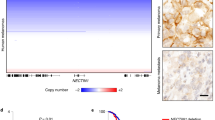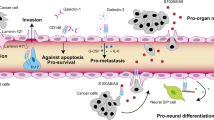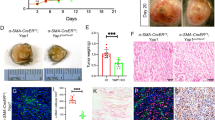Abstract
Normal human melanocytes are interspersed singly among keratinocytes along the basement membrane of the epidermis, whereas melanoma cells readily adhere to each other during invasion of the dermis or distant organs. The tumorigenic and metastatic phenotype of melanoma cells often correlates with increased expression of cell–cell and cell-matrix adhesion receptors. Mel-CAM (MCAM, MUC 18, CD146) is a cell–cell adhesion receptor highly expressed by melanoma cells but not normal melanocytes. We show here that inhibition of Mel-CAM expression in metastatic melanoma cells using genetic suppressor elements of Mel-CAM cDNA leads to inhibition of adhesion between melanoma cells and to downregulation of the tumorigenic phenotype. Growth was not inhibited in genetic suppressor elements-transduced melanoma cells cultured in monolayers but was inhibited when cells were maintained anchorage-independently in soft agar and greatly reduced in immunodeficient mice. A three-dimensional epidermal skin equivalent model demonstrated that Mel-CAM allows melanoma cells to separate from the epidermis and invade the basement membrane zone and dermis. However, melanoma cells with little or no Mel-CAM were poorly invasive, possibly due to their loss of gap junctional communication. These results suggest the multifunctional role of a melanoma-associated cell–cell adhesion receptor in tumor progression.
This is a preview of subscription content, access via your institution
Access options
Subscribe to this journal
Receive 50 print issues and online access
$259.00 per year
only $5.18 per issue
Buy this article
- Purchase on Springer Link
- Instant access to full article PDF
Prices may be subject to local taxes which are calculated during checkout





Similar content being viewed by others
Abbreviations
- CAM:
-
cellular adhesion molecule
- GSE:
-
genetic suppressor element
- PCR:
-
polymerase chain reaction
References
Anfosso F, Bardin N, Frances V, Vivier E, Camoin-Jau L, Sampol J, Dignat-George F . 1998 J. Biol. Chem. 273: 26852–26856
Bardin N, George F, Mutin M, Brisson C, Horschowski N, Frances V, Lesaule G, Sampol J . 1996 Tissue Antigens 48: 531–539
Bryant PJ . 1997 Dev. Genet. 20: 75–90
Cochlovius B, Zawadzki V, Perschl A, Zoller M . 1998 Adv. Exp. Med. Biol. 451: 345–348
Degen WG, van Kempen LC, Gijzen EG, van Groningen JJ, van Kooyk Y, Bloemers HP, Swart GW . 1998 Am. J. Pathol. 152: 805–813
Graham FL, Prevec L . 1995 Mol. Biotechnol. 3: 207–220
Gudkov AV, Kazarov AR, Thimmapaya R, Axenovich SA, Mazo IA, Roninson IB . 1994 Proc. Natl. Acad. Sci. USA 91: 3744–3748
Hannon GJ, Sun P, Carnero A, Xie LY, Maestro R, Conklin DS, Beach D . 1999 Science 283: 1129–1130
He TC, Zhou S, da Costa LT, Yu J, Kinzler KW, Vogelstein B . 1998 Proc. Natl. Acad. Sci. USA 95: 2509–2514
Herlyn D, Iliopoulos D, Jensen PJ, Parmiter A, Baird J, Hotta H, Adachi K, Ross AH, Jambrosic J, Koprowski H, Herlyn M . 1990 Cancer Res. 50: 2296–2302
Herlyn M . 1993 Molecular and Cellular Biology of Melanoma R.G. Landes Co., Austin pp 1–93
Holness CL, Simmons DL . 1994 J. Cell Sci. 107: 2065–2070
Hsu M, Andl T, Li G, Meinkoth JL, Herlyn M . 2000 J. Cell Sci. 113: 1535–1542
Hsu MY, Meier FE, Nesbit M, Hsu JY, Van Belle P, Elder DE, Herlyn M . 2000 Am. J. Pathol. 156: 1515–1525
Hsu MY, Shih DT, Meier FE, Van Belle P, Hsu JY, Elder DE, Buck CA, Herlyn M . 1998 Am. J. Pathol. 153: 1435–1442
Johnson JP . 1994 Invasion Metastasis 14: 123–130
Johnson JP . 1999 Cancer Metastasis Rev. 18: 345–357
Johnson JP, Bar-Eli M, Jansen B, Markhof E . 1997 Int. J. Cancer 73: 769–774
Johnson JP, Rummel MM, Rothbacher U, Sers C . 1996 Curr. Top. Microbiol. Immunol. 213: 95–105
Kath R, Jambrosic JA, Holland L, Rodeck U, Herlyn M . 1991 Cancer Res. 51: 2205–2211
Kraus A, Masat L, Johnson JP . 1997 Melanoma Res. 7: S75–S81
Krutovskikh V, Yamasaki H . 1997 Histol. Histopathol. 12: 761–768
Lehmann JM, Riethmuller G, Johnson JP . 1989 Proc. Natl. Acad. Sci. USA 86: 9891–9895
Levenson VV, Lausch E, Kirschling DJ, Broude EV, Davidovich IA, Libants S, Fedosova V, Roninson IB . 1999 Somat. Cell Mol. Genet. 25: 9–26
Li G, Herlyn M . 2000 Mol. Med. Today 6: 163–169
Lynch CM, Miller AD . 1991 J. Virol. 65: 3887–3890
Marcusson EG, Yacyshyn BR, Shanahan WR, Jr, Dean NM . 1999 Mol. Biotechnol. 12: 1–11
Meier F, Nesbit M, Hsu MY, Martin B, Van Belle P, Elder DE, Schaumburg-Lever G, Garbe C, Walz TM, Donatien P, Crombleholme TM, Herlyn M . 2000 Am. J. Pathol. 156: 193–200
Morgan RA, Couture L, Elroy-Stein O, Ragheb J, Moss B, Anderson WF . 1992 Nucleic Acids Res. 20: 1293–1299
Morimoto C, Tachibana K . 1996 Hum. Cell 9: 163–168
Naviany RK, Costanzi E, Haas M, Verna IM . 1996 J. Virol. 70: 5701–5705
Nesbit M, Herlyn M . 1994 Invasion Metastasis 14: 131–146
Pestov DG, Lau LF . 1994 Proc. Natl. Acad. Sci. USA 91: 12549–12553
Pickl WF, Majdic O, Fischer GF, Petzelbauer P, Fae J, Waclavicek M, Stockl J, Scheinecker C, Vidicki T, Aschauer H, Johnson JP, Knapp W . 1997 J. Immunol. 158: 2107–2115
Roninson IB, Gudkov AV, Holzmayer TA, Kirschling DJ, Kazarov AR, Zelnick CR, Mazo IA, Axenovich S, Thimmapaya R . 1995 Cancer Res. 55: 4023–4028
Rummel MM, Sers C, Johnson JP . 1996 Cancer Res. 56: 2218–2223
Sambrook J, Maniatis T, Fritsch EF . 1989 Molecular Cloning: A Laboratory Manual Cold Spring Harbor Laboratory, Cold Spring Harbor, NY, USA
Satyamoorthy K, DeJesus E, Linnenbach AJ, Kraj B, Kornreich DL, Rendle S, Elder DE, Herlyn M . 1997 Melanoma Res. 7: S35–S42
Sers C, Riethmuller G, Johnson JP . 1994 Cancer Res. 54: 5689–5694
Shih IM . 1999 J. Pathol. 189: 4–11
Shih IM, Elder DE, Speicher D, Johnson JP, Herlyn M . 1994 Cancer Res. 54: 2514–2520
Shih IM, Speicher D, Hsu MY, Levine E, Herlyn M . 1997 Cancer Res. 57: 3835–3840
St Croix B, Rago C, Velculescu V, Traverso G, Romans KE, Montgomery E, Lal A, Riggins GJ, Lengauer C, Vogelstein B, Kinzler KW . 2000 Science 289: 1197–1202
Xie S, Luca M, Huang S, Gutman M, Reich R, Johnson JP, Bar-Eli M . 1997 Cancer Res. 57: 2295–2303
Yagi T, Takeichi M . 2000 Genes Dev. 14: 1169–1180
Yamasaki H . 1996 Mutat. Res. 365: 91–105
Acknowledgements
We thank the members of the Editorial Department for their assistance. This work was supported in part by NIH grants CA47159, CA25874, CA76674, CA74294, DK50306, CA10815, and by NASA grant NAG9-832, and by funding from Mary AH Rumsey Foundation.
Author information
Authors and Affiliations
Corresponding author
Rights and permissions
About this article
Cite this article
Satyamoorthy, K., Muyrers, J., Meier, F. et al. Mel-CAM-specific genetic suppressor elements inhibit melanoma growth and invasion through loss of gap junctional communication. Oncogene 20, 4676–4684 (2001). https://doi.org/10.1038/sj.onc.1204616
Received:
Revised:
Accepted:
Published:
Issue Date:
DOI: https://doi.org/10.1038/sj.onc.1204616
Keywords
This article is cited by
-
CD146, a novel target of CD44-signaling, suppresses breast tumor cell invasion
Cell Communication and Signaling (2017)
-
Minimal residual disease in melanoma: circulating melanoma cells and predictive role of MCAM/MUC18/MelCAM/CD146
Cell Death Discovery (2017)
-
Semaphorin 3A upregulates FOXO 3a-dependent MelCAM expression leading to attenuation of breast tumor growth and angiogenesis
Oncogene (2015)
-
Mcam Silencing With RNA Interference Using Magnetofection has Antitumor Effect in Murine Melanoma
Molecular Therapy - Nucleic Acids (2014)
-
Sequential molecular analysis of circulating MCAM/MUC18 expression: a promising disease biomarker related to clinical outcome in melanoma
Archives of Dermatological Research (2014)



